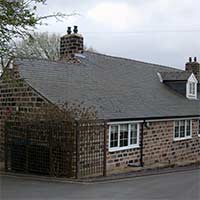
Click for info
On, or very near this site, which used to be known as Staincross Ridge, stood the rented cottage of James Taylor, the great grandfather of James Hudson Taylor. He was a stonemason by trade working for Wentworth Blackett Beaumont, an estate landlord.
It is recorded by a local Methodist historian, Edward Taylor (no relation), that it was here on the morning of Thursday 1st February 1776 that James was gathering wheat sheaves in a barn and preparing his rented cottage for his bride to be, Elizabeth Johnson, who he was to marry at 12 noon that day in Royston Parish Church.
As he was about his business James had what he believed was a vivid experience of the love of Christ. It embraced him and gave him renewed vigour and direction in his life.
James may also have been thinking about the Christian witness of his neighbours Joseph and Elizabeth Shaw. Elizabeth Shaw, it was recorded, had a miraculous healing from crippling rheumatism which had made such a stir in the neighbourhood. She said it was all due to prayer and ‘trust in the Lord’. James also, was possibly thinking about the preaching of John Wesley, when he preached at 11am in Mapplewell at the fair held in the open air on ‘Feast Monday’ July 27th 1761; or when Wesley possibly stayed with the Shaws, when he was en route between Leeds and Sheffield, the following year.
Preachers of the new ‘revival’ from Wakefield regularly preached in Staincross and Mapplewell around 1760, but the area was notorious for what was known as ‘bating the Methodists’. However, on the occasion of Wesley’s preaching people listened attentively.
At the outset of their married life at Staincross, James had decided to join this new revival, later called Methodism. However, Elizabeth (known as Betty), was reluctant at first, to join her husband in the new ‘revival’ but later relented and joined him.
Along with other local families, the Shaws, the Coopers and others, James and Elizabeth Taylor had discovered the evangelical movement that was emerging across the nation in answer to what was seen by some as the dissolute attitudes and corruption found in many parts of society at that time. They had joined a movement which was led not only by the Wesleys, but also by Whitfield, Grimshaw, Rowland, Berridge and others. Their little group helped form the first Methodist society in Staincross.
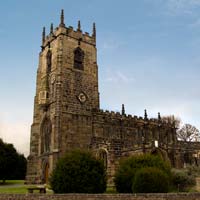
Click for info
Built before 1234 by the monks of nearby Monk Bretton Priory, the tower features an oriel window, one of only three church oriel windows in England. It was a small chamber possibly used for meditation and prayer, and also it was used as a guide for travellers. This is the church where James Taylor married Elizabeth Johnson on February 1st 1776.
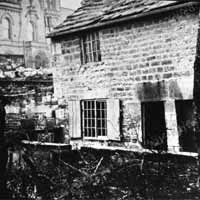
Photograph ©Tasker Trust
Click for info
The cottage in the first photograph is very probably one of the block that James Taylor helped to build. In the background can be seen the NUM offices on Huddersfield Road.
James Taylor, as a stonemason, possibly worked for local bricklayer and plasterer, Willoughby Flower, who had enclosed a quarry on the northern edge of Barnsley town, known as Folly Quarry. It was situated on the north side at the top of Old Mill Lane. On that site, Flower built a block of seven cottages. The exact date when these were built is not known but it was less than twenty years before the Commons Inclosure Act of 1777.
On November 5th 1776, Elizabeth Taylor gave birth to their first-born, John. By 1777, James and Elizabeth Taylor and their son John had moved into the second cottage from the top of Old Mill Lane; a four roomed cottage that James may have had a hand in building.
At that time Old Mill Lane was the main north road out of Barnsley leading to Wakefield and Leeds and was known as the Sheffield and Wakefield turnpike road. Stagecoaches and other horse drawn vehicles from the town and market travelling north, would pass along Kirkgate by St Mary’s Church and pause at the top of Old Mill Lane before the steep descent down Old Mill Lane. Breaking hard, the coachmen would strenuously guide their horses, sometimes bearing heavy loads, as they negotiated the rough steep lane, (especially difficult in inclement weather), before crossing the River Dearne at the bottom and carrying on the road north.

Click for info ©Tasker Trust
However, James and Elizabeth (Betty) found the cost of living more expensive than in the rural area from where they had come, even though James was earning more than as a stone mason – twelve shillings a week – this was because they now had a family consisting of two sons and three daughters.
After all their weekly expenses had been met they found they had one shilling and six pence extra. Rather than save it for ‘comforts’, or for a ‘rainy day’, James and Betty decided they would sacrifice it ‘to the support of God’s cause and the relief of the poor’. In the ‘world’s’ eyes they were considered poor, yet James and Betty considered themselves ‘rich towards God’.
James and Betty’s home was always a welcoming place. Eventually meetings and classes in Christian doctrine were held in the cottage. This was the first Methodist class meeting in Barnsley. It was initially composed of seven people James and Betty Taylor, Jonathan Pashley, John Denton (weaver), Timothy Peckett (mason), Thomas Blackburn (farmer) and his wife.
It is not known what contact James and Elizabeth had with the Reverend John Mence the younger, rector at the time of their parish church of St. Mary the Virgin on Church Street. Although the Established Church during this period was in a moribund state some parish clergy however, though well educated, were poor, but cared for their parishioners. Rev. J Mence had difficulty providing for his family but the Mence family were, in 1906, remembered as ‘one of the oldest and most respected Barnsley families.’
Barnsley was rough and uncouth in character and many of the population never had much in the way of religious teaching, but James Taylor felt called to bring the Gospel to the people of Barnsley and would regularly preach in the market place and around the town. But he often encountered scorn, jeers and violent opposition. He was pelted with stones and refuse; sometimes he was physically assaulted, being dragged in mud and dirt and often with his life in danger. On one occasion he had a mixture of ground glass and mud rubbed in his eyes; this caused him to be off work and sightless for a time.
But none of these things deterred him however. Instead, he felt great joy in his heart and empowered by God to serve others and bringing the Bible to them.
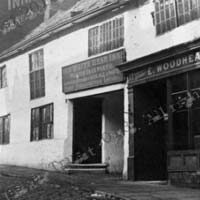
Photograph ©Tasker Trust
Click for info
In the early years of the Industrial Revolution, Barnsley had a reputation for being rough, with drunkenness and licentiousness being prominent. In the growing towns across the country notices on ale-houses at the time give an impression of the conditions: Drunk – a penny, dead drunk – two pence, clean straw for nothing
.
Archbishop of Canterbury Thomas Secker commenting on the social attitudes of the nation in the second half of the eighteenth century in his Eight Charges of 1769 wrote:
‘…that an open and professed disregard of religion is become, through a variety of unhappy causes, the distinguishing character of the age. Such are the dissoluteness and contempt …and the profligacy, intemperance and fearlessness of committing crime... if the torrent of impiety stop not, become absolutely fatal.’
From his journals it seems John Wesley, called ‘the best-known man in England’
, passed through, or visited, Barnsley on at least twenty occasions and possibly made three short stays in the town. However, his visit to Barnsley on Friday June 30th 1786, after driving over the Hickleton Hills and through the beautiful valley of the Dearne, is the only time he is recorded as having preached. Upon his arrival he made for the Old White Bear Inn, on the site of St. Mary’s Place and Shambles Street; it was about noon. After dining, around 1.30pm, he went into the yard to preach to the assembling crowd (the bell-man had been into the town to announce his visit). Wesley mounting the stone steps of an outbuilding, which are now outside Emmanuel Church on Huddersfield Rd, delivered a sermon taking his Bible text from Hebrews chapter 9 v 27 And as it is appointed unto men once to die, but after this the judgement.
, (K J Bible). His earnestness, authenticity and power were fondly remembered by many in the large attentive crowd gathered into the yard.
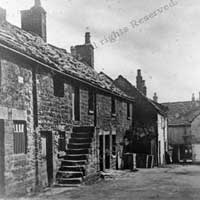
Photograph ©Tasker Trust
Click for info
At 2.45pm he sent for his chaise and set out for Rotherham where he preached again that evening. Although he was 83 years old, it was evident his faith and energy were unabated. He had travelled 30 miles that day and preached three times making in all a probable seventeen and half hours day.
After this visit to Barnsley he wrote in his Journal the following entry:
Friday June 30th, 1786: I turned aside to Barnsley, formerly famous for all manner of wickedness. They were then ready to tear any Methodist preacher in pieces. Now not a dog wagged its tongue. I preached near the Market Place to a very large congregation, and I believe the truth sank into many hearts. They seemed to drink in every word. Surely God will have a people in this place.
At this visit by John Wesley, James and Elizabeth (Betty) Taylor, being the founders of the first Methodist society in Barnsley, must have been present and either, renewed their acquaintance with Wesley following his previous visits to Barnsley and Staincross, or possibly was meeting him for the first time.
John and Charles Wesley, along with Whitfield, Grimshaw and others of the great Evangelical Revival of the eighteenth century, brought vast changes that eventually had repercussions which altered the whole face of Church and State and thereby had a great influence on the social character of the nation.
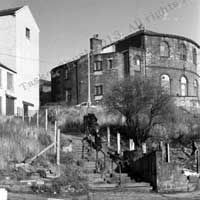
Photograph ©Tasker Trust
Click for info
Whilst at Old Mill Lane John fell in love with Mary Shepherd who was living in Darfield, a village five miles from Barnsley. In May 1799 they were married at All Saints Church, Darfield. They moved into a little cottage, which was known as ‘Sten Court, five house’ near to the Pin Fold and Westgate Chapel on Pinfold Hill, possibly known at the time as Pit or Coal Pit Hill.
John and Mary were Bible Class leaders teaching young children and following the example of Robert Raikes of Gloucester, who innovated the revolutionary idea of ‘Sunday Schools’, John set about gathering the untaught children of the streets. On the day John and Mary began their Sunday School no fewer than six hundred children crowded in to be taught; so many the chapel was not big enough to contain them!
John and Mary had seven children of their own. One of them, James, was the father of James Hudson Taylor.
At the foot of Pinfold Hill was Westgate, which was then the main west road out of Barnsley and at the bottom of the road it was met by Summer Lane to the right, Racecommon Road straight ahead to the top at Kingstone. On the land facing, across Racecommon Road, Shaw Lands and Barnsley Moor towards Pogmoor and Gawber, coal was being extracted from small pits and outcropping.
To the left of Westgate and in the foreground flowed Sough Dike and over it to the right on the higher ground, known then as Peashills, was the then new Pitt Street. John Taylor had built there a plain substantial house with workshops.
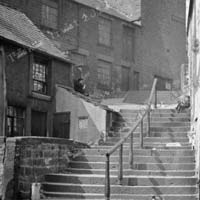
Photograph ©Tasker Trust
Click for info
Whilst at Old Mill Lane John fell in love with Mary Shepherd who was living in Darfield, a village five miles from Barnsley. In May 1799 they were married at All Saints Church, Darfield. They moved into a little cottage, which was known as ‘Sten Court, five house’ near to the Pin Fold and Westgate Chapel on Pinfold Hill, possibly known at the time as Pit or Coal Pit Hill.
John and Mary were Bible Class leaders teaching young children and following the example of Robert Raikes of Gloucester, who innovated the revolutionary idea of ‘Sunday Schools’, John set about gathering the untaught children of the streets. On the day John and Mary began their Sunday School no fewer than six hundred children crowded in to be taught; so many the chapel was not big enough to contain them!
John and Mary had seven children of their own. One of them James, was the father of James Hudson Taylor.
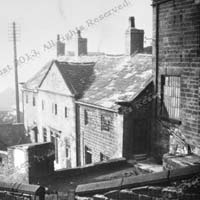
Photograph ©Tasker Trust
Click for info
At the foot of Pinfold Hill was Westgate, which was then the main west road out of Barnsley and at the bottom of the road it was met by Summer Lane to the right, Racecommon Road straight ahead to the top at Kingstone. On the land facing, across Racecommon Road, Shaw Lands and Barnsley Moor towards Pogmoor and Gawber, coal was being extracted from small pits and outcropping.
To the left of Westgate and in the foreground flowed Sough Dike and over it to the right on the higher ground, known then as Peashills, was the then new Pitt Street. John Taylor had built there a plain substantial house with workshops.
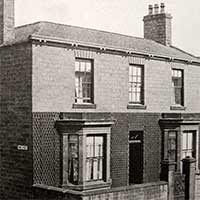
Click for info
Business prospered for John Taylor; so much that he decided to have a suitably plain, but substantial house built on the new Pitt Street opposite the then new St. George’s Church, (built 1823).
The house that John and Mary and their children moved into in 1825 was large enough to accommodate workshops and from the back the chapel on Pinfold Hill could clearly be seen.
John and Mary Taylor encouraged their children by their example and supported them by prayer and in teaching them the Christian faith. They also helped their children to choose, within limits, their life paths. One joined his father in business; one became a stockbroker in Manchester, another became a Wesleyan minister and James, an omnivorous reader, keen on mathematics and though ambitious to be a doctor, had to be satisfied with the less expensive training of a chemist and went to train in Rotherham.
When he was nineteen James became an accredited local preacher of the Wesleyan Methodist Church and was remembered for his thoughtful and well prepared sermons.
James Taylor had a forceful and powerful personality. He was known for his strong Christian faith; his discipline, as well as his thoroughness and determination.
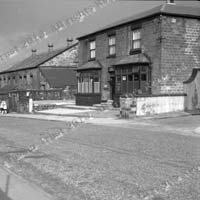
Photograph ©Tasker Trust
Click for info
Across Pitt Street from the Taylor’s home and a few yards towards the town centre stood the Wesleyan Manse, the home of Wesleyan Minister Rev’d Benjamin and Mrs Hudson and their children. They arrived in 1824 and both families became very close friends. Many Sunday evenings, after evening service they enjoyed further singing in the Taylor’s home.
Rev’d Hudson was a talented amateur artist with an interest in portrait painting. This artistic talent was inherited by three of his children; two of them, Benjamin and his sister Hannah became celebrated artists. Hannah travelled and taught drawing in Tasmania in the 1830s and was a professional portrait painter in Hull. Benjamin painted portraits in India and possibly exhibited at the Royal Academy. Hannah painted family portraits, including her sister Amelia, (J Hudson Taylor’s mother), James Hudson Taylor and his sister Amelia Hudson Taylor.
The Hudson’s eldest, a daughter, Amelia, was renowned for her singing voice; John Taylor called her ‘the nightingale’.
Amelia was a delight to her parents. She was thoughtful, industrious and a good scholar. However, she had to give up her studies because it had not been possible for her parents to pay for her continued studies because her younger sisters needed education. So Amelia left to work as a governess for a gentleman farmer in Castle Donnington.
James Taylor, in the meantime, continued diligently with his studies and training as a chemist, visiting home whenever time allowed.
When she had the opportunity, Amelia also loved to visit home. It was during these visits that John and Amelia became close and soon their engagement was announced.

Photograph ©Tasker Trust
Click for info
The rapid growth of the linen trade in Barnsley at the close of the eighteenth and early nineteenth centuries brought about an increase in the population and the need to build houses for accommodation. The area around Pitt Street known locally as Peashills, Tumbling Hill and the Ing, was an area of Closes, or parcels of land. In addition to the housing, a number of churches and chapels were built in the area around this time. One such was Pitt Street Methodist Chapel, built at a cost of £5,000 and opened on October 8th 1846 in the presence of a large number of people and the Trustees, which included James Taylor.
A ‘Dr Hudson Taylor and Dr & Mrs Howard Taylor’ are recorded as having preached from the pulpit and platform of this chapel, but no dates are known.
It is recorded James Hudson Taylor addressed the congregation in this chapel in 1891.
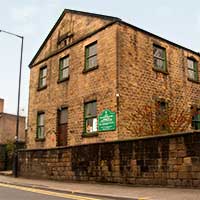
Photograph ©Tasker Trust
Click for info
This chapel was built in 1825, the year John Taylor and his family moved into 39 Pitt Street. It has seating for 350 people and the school was added later, opening in 1852.
It was built as a town centre Congregational Chapel and formed part of the Congregational Church until 1857 when it was sold following a dispute with the Wesleyan Church and re-opened as a Wesleyan Reform Chapel in 1858.
Salem Chapel is basically unchanged since the time when the Taylor family attended, both in Congregational times and after the chapel became part of the Wesleyan Reform Union.
In Salem Chapel there is an impressive brass tablet commemorating the memories of James Taylor, described as a ‘distinguished citizen of this town.’ and his son, God’s humble servant, James Hudson Taylor MRCS founder of the China Inland Mission.
James Hudson Taylor preached in this chapel in 1861 and other local churches and chapels when he made return a visit to England to recruit missionaries and raise funds for the China Inland Mission.
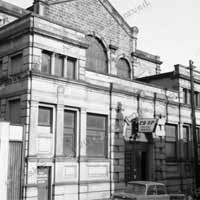
Photograph ©Tasker Trust
Click for info
Opposite Salem Wesleyan Reform Chapel was the Wesleyan Methodist Association Chapel. This building was originally built as a Chapel in 1829 by Barnsley-born architect and zealous Sunday School teacher John Whitworth, who was also responsible for the enlargement of Westgate Chapel.
James Hudson Taylor attended meetings in this chapel.
The new front to the building was added in 1901. After it ceased to be a chapel in 1958, it was acquired by the Barnsley British Co-operative Society and in 1982 became Hope House Church and Christian School.
In 1860, two Sunday School teachers, Mr and Mrs J. J. Meadows, from the Wesleyan Methodist Association Chapel, joined Hudson Taylor at the beginning of the China Inland Mission and are recorded by E G Bayford thus, ‘Mrs Meadows did many years of noble service, and Mr Meadows toiled magnificently in China for more than half a century.’
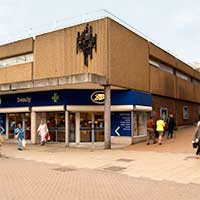
Click for info
Upon completion of his apprenticeship James Taylor was advanced money by his father to enable him to rent 21 Cheapside on the busy May Day Green, opposite the busy market in Barnsley, as a chemist shop.
Barnsley was a lively place around the time James Taylor moved into Cheapside. A local historian Eli Hoyle writes:
1829 was the most extraordinary year in the annals of Barnsley: robberies, resurrectionists, meetings to oppose Catholic Emancipation, local distress, riots, arson, manslaughter, and meetings concerning free trade.
Another local historian, John Hugh Burland, tells of:
…a five months strike by the weavers and terrible privation. Riots were frequent occurrence... On August 28th, Barnsley presented the appearance of being in the throes of a revolution. Guns, swords, pistols and blunderbusses were used for personal defence, and every linen warehouse was converted into a garrison. The Dragoons were ready to mount at a moments notice.’
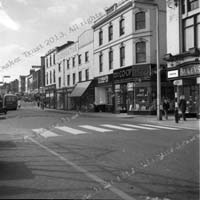
Photograph ©Tasker Trust
Click for info
So it was a serious undertaking for the young James Taylor, but the situation was one of the best in Barnsley and with James’ thoroughness and self discipline he made a success of his career and gained himself a reputation for regularity and honesty in his affairs. He worked six days each week and on Sundays he had his preaching appointments on the local Wesleyan Methodist Church Circuit. One of his sisters became his housekeeper enabling him to fulfil his work engagements.
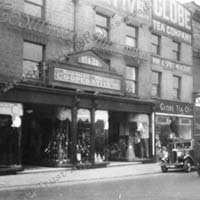
Photograph ©Tasker Trust
Click for info
James Taylor became one of the founders of the Barnsley Permanent Building Society. It is highly probable that the Society began operating from 21 Cheapside before it moved to Market Hill, near the corner of Shambles Street and Market Hill. James was for many years Acting Manager and after his retirement he continued to devote a considerable amount of time to the Society.
Although esteemed for his integrity and character, above everything, James was known for his strong faith in God, which guided him in all aspects of his life.
After repaying his father’s loan he had established his home on the premises. He had gained sufficient regular income and was now able to marry Amelia Hudson on April 5th 1831 at St Mary’s Church in Barton upon Humber, where Amelia was living during their long seven year engagement while her father was in charge of the Barton Methodist Circuit.
After the wedding James and Amelia Taylor set up home at 21 Cheapside, Barnsley and it was here on May 21st 1832 their first child was born and named after both parents – James Hudson Taylor.
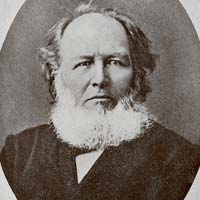
Click for info
Young James Hudson Taylor was a sensitive, bright and thoughtful child, but from early childhood he suffered from ill health. For much of his childhood he was taught at home by both parents because he was unable to attend school, apart from between the ages of twelve to fourteen.
The influence of both parents, especially his father, cannot be overstated. For instance, his father engaged young Hudson in conversation, telling him of the books he was reading, which included the life and work of missionaries. When he was very young, James Hudson was remembered saying, ‘When I am a man, I mean to be a missionary and go to China’. Like his father, James Hudson was a voracious reader.
It was in his early youth in Barnsley that Hudson had his first spiritual experiences. The first, when he was seven years old, he accompanied his father around the area connected with the Methodist Centenary celebrations in 1839. It was around this time that Hudson and his sister Amelia became deeply interested in a book, China by Peter Parley, which they read many times and both resolved to visit China when they were adults. In Hudson’s case, this was not thought possible to his parents because of his delicate nature.
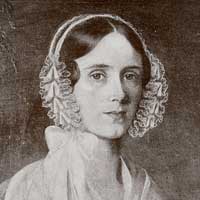
Click for info
Although he generally took life seriously, Hudson is said to have had a sunny nature and he loved boyish fun. He was interested in many things, but nature study was a great interest to him. On one occasion a fair of unusual interest to him with a variety of birds and animals came to Barnsley and was held on Churchfield, not far from Westgate chapel. Young Hudson Taylor tried in vain to access it but without success.
Hudson Taylor’s brief time at school, was spent at a day school run by a Mr Laycock near his grandfather’s home on Pitt Street. It brought him in touch with the life and discipline of school. Around this time he took part in a camp held in a park near Leeds. There he heard Henry Reed relate his experiences as a missionary in Tasmania. This made a deep and lasting impression on young Hudson Taylor. Later, Henry Reed became a great supporter of the China Inland Mission.
Just before Christmas 1845, when he was thirteen years old, Hudson Taylor began to assist his father in the chemist shop at 21 Cheapside. In between working in the shop he enjoyed his father’s library and the study of dispensing. In 1846 he made his first definite commitment to God. This was brought about by reading a leaflet published by the Religious Tract Society. A few years later Hudson wrote:
From my earliest childhood I have felt the strivings of the Holy Spirit, and when about fourteen years of age I gave my heart to God.
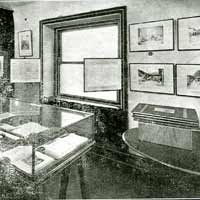
Click for info
This spiritual experience was real and true to him and he held to this commitment, but as he entered his mid teens Hudson underwent spiritual unrest.
It was a period of searching, questioning, doubt and testing. Later in life he wrote:
...I have often been thankful for this time of scepticism.
Further, he wrote:
…and I frequently felt at that time, and said, that if I pretended to believe the Bible I would at any rate attempt to live by it, putting it fairly to the test, and if it failed to prove true and reliable, would throw it overboard altogether. These views I retained when the Lord was pleased to bring me to Himself; and I think I may say that since then I have put God’s Word to the test. Certainly it has never failed me.
The final photograph in this section shows the James Hudson Taylor Birthplace Museum c1930. In the 1950s BBCS staff remembered Chinese Christians visiting the site of James Hudson Taylor’s birthplace. Through an open arch on the first floor of the store, was the store staffroom; it is thought this was originally the Taylor’s parlour. To the right of the entrance was a narrow wooden staircase which led to the room above where James Hudson Taylor was born. For a time, this became the Birthplace Museum.
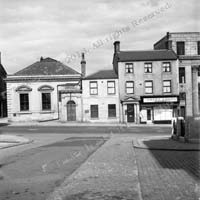
Photograph ©Tasker Trust
Click for info
In 1847, at fifteen years of age James Hudson Taylor obtained a post as a junior clerk in a bank on Church Street, Barnsley, known at the time as the Wakefield and Barnsley Bank. It was regarded at the time as one of the best banks in Barnsley, where banking dated back to 1796.
The position as a junior clerk was an opportunity his father was anxious he should take feeling that whatever the future might bring good business training would be useful to Hudson.
At the bank, Hudson was well trained in accountancy and business correspondence and the necessity for promptness and accuracy in financial affairs.
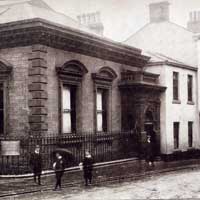
Click for info
Hudson’s time at the bank also proved invaluable for him in working with others in the busy commercial world. It was also during this time of spiritual turmoil that led Hudson Taylor, for a time, to set his heart on wealth and worldly pleasures. He had been influenced by the scepticism and hedonistic attitudes of those he associated and worked with. One of Hudson Taylor’s colleagues mocked his Christian views.
Overtime work at the bank, especially working by gas-light, caused inflammation in his eyes. Although he tried medication nothing brought relief and after nine months of book keeping he had to resign from his post and return to working as an assistant in his father’s chemist shop. During this time he continued to study Latin, Greek, Theology and Medicine.
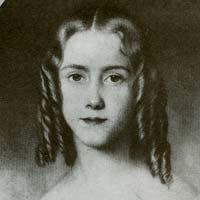
Click for info
But his intense spiritual struggle and the wrestling in his soul went on for many months. It was a state that caused much unhappiness in his home. He became sullen. His father tried to help him, but found it hard to be patient with what Hudson was going through. However, his mother understood him better and prayed regularly for him, but it was thirteen years old Amelia, his sister, who won his confidence. Hudson opened his heart to her and she even resolved to pray three times each day for him until he recovered.
Hudson Taylor’s spiritual crisis continued many months, but eventually came to a head on Sunday December 2nd 1849, at seventeen years of age. He was alone in his father’s study casually reading. His mother and his sister Amelia were away. Hudson had written to Amelia, who was staying with Mrs Hodson, their mother’s sister; (she ran a school in Barton-on-Humber), asking her to pray for him. Unknown to him, Hudson’s mother was also praying earnestly for him at the same time.
Alone, Hudson Taylor suddenly had what he believed, to be an intense spiritual experience of God; a joyful conviction of what Christ had achieved for him and the whole world. He later wrote:
Never shall I forget the feeling that came over me then. Words can never describe it. I felt I was in the presence, entering into covenant with the Almighty …Something seemed to say ‘Your prayer is answered…and from that time the conviction never left me that I was called to China.
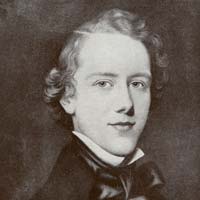
Click for info
The China Inland Mission, begun by James Hudson Taylor in 1865, became after his death in 1905, the largest Protestant mission in the world.
Historian Kenneth Scott Latourette wrote of James Hudson Taylor:
In some ways the China Inland Mission was unique in the entire history of the expansion of Christianity. It had the backing of no denomination or powerful ecclesiastical body. It arose out of the devotion of one man, Hudson Taylor.
In no other land of so large an area and population was there ever a single society which planned so comprehensively to cover the whole and came so near to fulfilling its dream.
Historian Ruth Tucker wrote of James Hudson Taylor:
No other missionary in the nineteenth centuries since the Apostle Paul has had a wider vision and has carried out a more systematic plan of evangelising a broad geographical area than Hudson Taylor.

Click for info
At the front of this church can be seen the remains of the steps from the yard of the Old White Bear Inn, Westgate, Barnsley, from which it is said the 83 years old John Wesley preached to a large expectant crowd on Friday June 30th 1786.
Hudson Taylor In Early Years: The Growth of a Soul by Dr and Mrs Howard Taylor
Hudson Taylor: The Man who Believed God by Marshall Broomhall
James Hudson Taylor – The Barnsley Connection by Colin Reasbeck
John Wesley and his visits to Barnsley Barnsley Archives and Local Studies
Eight charges delivered to the clergy of the dioceses of Oxford and Canterbury 1769 by Archbishop Thomas Secker
The Journal of John Wesley by John Wesley
A History of the Church in England by J R H Moorman
The Golden Years are the Years Ahead 1846 Centenary 1946 Pitt Street Methodist Church Barnsley
The Movements that have helped to make the United Methodist Church by Mr E. G. Bayford F.E.S.
Early Methodism in Barnsley by J Knee
E. G. Bayford Bequest Barnsley Archives and Local Studies
The Making of Barnsley by Brian Elliott
Barnsley Streets by E G Tasker
Vanishing Relics of Barnsley by Gerald Alliott
Heirs Together or The Grace of Life by Marshall Broomhall
A History of the Expansion of Christianity vol 6 by K S Latourette
From Jerusalem to Irian Jaya. A Biographical History of Christian Missions by Ruth Tucker
The staff of Barnsley Archives and Local Studies
The Tasker Trust
Gerald Alliott
Harold Taylor
Barnsley Art on Your Doorstep